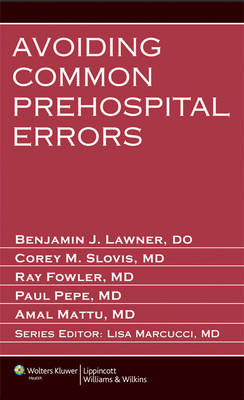
- Afhalen na 1 uur in een winkel met voorraad
- Gratis thuislevering in België vanaf € 30
- Ruim aanbod met 7 miljoen producten
- Afhalen na 1 uur in een winkel met voorraad
- Gratis thuislevering in België vanaf € 30
- Ruim aanbod met 7 miljoen producten
Avoiding Common Prehospital Errors
Benjamin J Lawner, Corey M Slovis, Raymond Fowler, Paul Pepe, Amal Mattu
Paperback | Engels
€ 96,95
+ 193 punten
Omschrijving
Avoiding Common Prehospital Errors, will help you develop the deep understanding of common patient presentations necessary to prevent diagnostic and treatment errors and to improve outcomes. Providing effective emergency care in the field is among the most challenging tasks in medicine. You must be able to make clinically vital decisions quickly, and perform a wide range of procedures, often under volatile conditions.
Written specifically for the prehospital emergency team, this essential volume in the Avoiding Common Errors Series combines evidence-based practice with well-earned experience and best practices opinion to help you avoid common errors of prehospital care.Look inside and discover...- Concise descriptions of each error are followed by insightful analysis of the "hows" and "whys" underlying the mistake, and clear descriptions of ways to avoid such errors in the future.
- "Pearls" highlighted in the text offer quick vital tips on error avoidance based on years of clinical and field experience.
- Focused content emphasizes "high impact" areas of prehospital medicine, including airway management, cardiac arrest, and respiratory and traumatic emergencies.
Written specifically for the prehospital emergency team, this essential volume in the Avoiding Common Errors Series combines evidence-based practice with well-earned experience and best practices opinion to help you avoid common errors of prehospital care.Look inside and discover...- Concise descriptions of each error are followed by insightful analysis of the "hows" and "whys" underlying the mistake, and clear descriptions of ways to avoid such errors in the future.
- "Pearls" highlighted in the text offer quick vital tips on error avoidance based on years of clinical and field experience.
- Focused content emphasizes "high impact" areas of prehospital medicine, including airway management, cardiac arrest, and respiratory and traumatic emergencies.
Specificaties
Betrokkenen
- Auteur(s):
- Uitgeverij:
Inhoud
- Aantal bladzijden:
- 452
- Taal:
- Engels
Eigenschappen
- Productcode (EAN):
- 9781451131598
- Verschijningsdatum:
- 29/09/2012
- Uitvoering:
- Paperback
- Formaat:
- Trade paperback (VS)
- Afmetingen:
- 124 mm x 203 mm
- Gewicht:
- 498 g

Alleen bij Standaard Boekhandel
+ 193 punten op je klantenkaart van Standaard Boekhandel
Beoordelingen
We publiceren alleen reviews die voldoen aan de voorwaarden voor reviews. Bekijk onze voorwaarden voor reviews.








